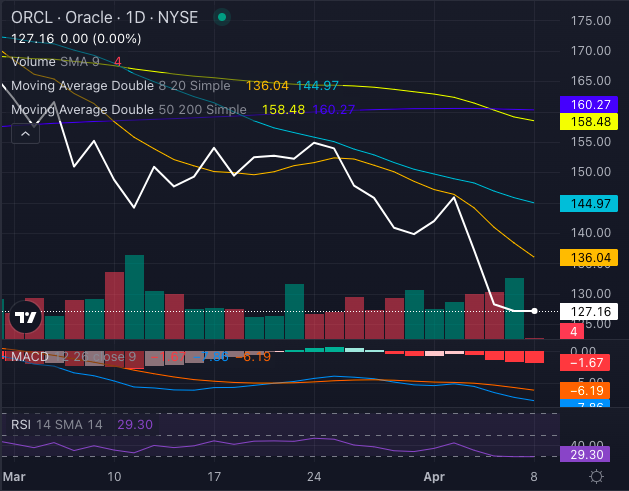Oracle Corp ORCL stock just flashed a Death Cross, and the chart tells a very different story for a company trying to rewrite its cloud destiny.

Chart created using Benzinga Pro
Oracle stock, at $127.16, is well below its 50-day simple moving average (SMA) of $158.48 and 200-day SMA of $160.27. When a stock’s 50-day average drops below the 200-day, it triggers what technical analysts call a death cross – and it’s not exactly a sign of bullish momentum.
Read Also: $74 Billion Wiped Out Since Tariff Declaration — See How Much The Billionaires Lost
All Signals Point Bearish – Despite A Tuesday Bounce
Even with a brief 3.83% pop on Tuesday morning, Oracle stock remains down over 20% year to date and has shed more than 11% in the past month. The trend is considered strongly bearish, with the share price trading under its eight, 20 and 50-day SMAs.
Oracle stock’s Relative Strength Index (RSI) of 29.30 suggests the stock is oversold, while a Moving Average Convergence Divergence (MACD) of a negative 7.86 reinforces the bearish tone.
Simply put, the technical backdrop is grim – and buyers seem to be lurking, but not committing.
Cloud Ambitions In A Tiered Universe
Fundamentally, it’s not all bad news. Cantor Fitzgerald just reaffirmed its ‘Overweight’ rating, citing Oracle’s expanding footprint in cloud infrastructure. But context matters. While Amazon.com Inc‘s AMZN Amazon Web Services and Microsoft Corp‘s MSFT Azure dominate as tier-one providers, Oracle is still fighting for relevance – sitting in the third tier behind Alphabet Inc‘s GOOGL GOOG Google Cloud Platform.
Oracle’s cloud push has leaned heavily on its GPU hardware capabilities and generous discounting to draw in customers. The effort is slowly moving it beyond its legacy base, but Wall Street isn’t seeing a near-term payoff just yet.
Strong Margins, Weak Momentum
Oracle still boasts a hefty market cap of $368 billion and an enviable gross profit margin of 71.12%.
But even strong fundamentals can’t hide from a faltering chart. Right now, Oracle’s numbers look better on paper than they do in pixels.
Read Next:
Image: Shutterstock
Market News and Data brought to you by Benzinga APIs